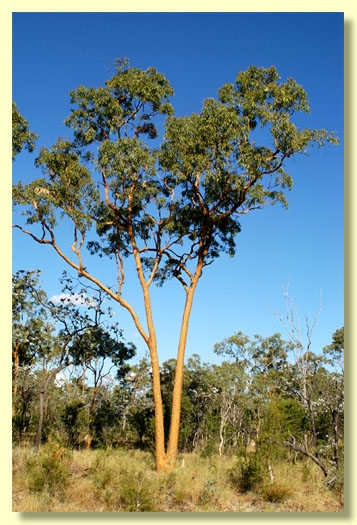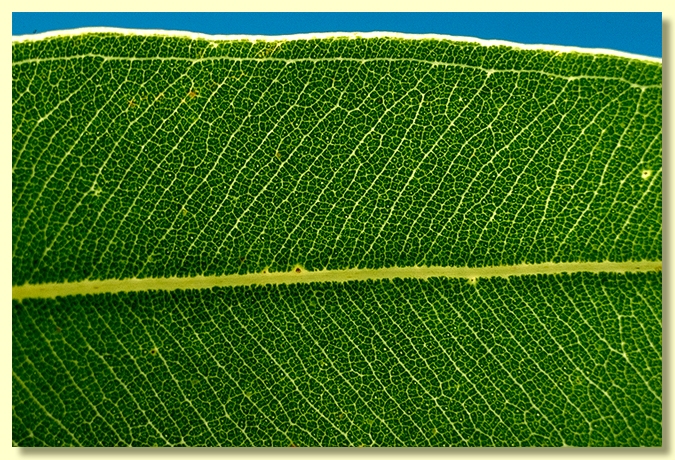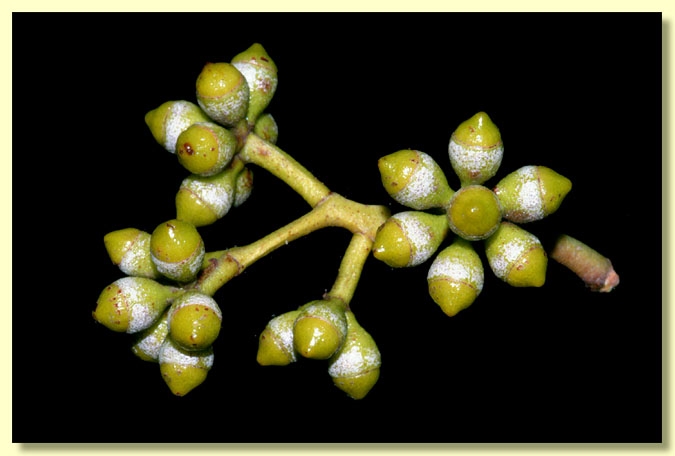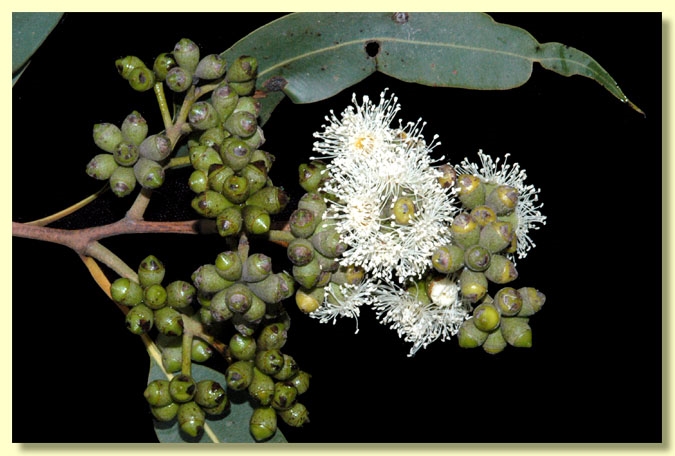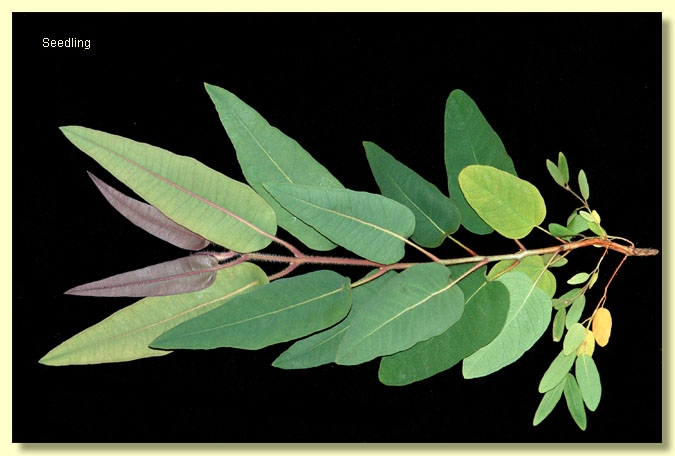Euclid - Online edition
Corymbia leichhardtii
Corymbia | Ochraria
Corymbia leichhardtii (F.M.Bailey) K.D.Hill & L.A.S.Johnson, Telopea 6: 370 (1995).
Eucalyptus leichhardtii F.M.Bailey, Queensland Agric. J. 16: 493 (1906); Eucalyptus eximia var. leichhardtii (F.M.Bailey) Ewart, Victorian Naturalist 24: 56 (1907); Eucalyptus peltata subsp. leichhardtii (F.M.Bailey) L.A.S.Johnson & Blaxell, Contrib. New South Wales Nat. Herb. 4: 453 (1973). T: Queensland, near Alice, Central Railway, Dec. 1905, W.Pagan s.n.; holo: BRI; iso: K, MEL, NSW.
Tree to 15 m tall. Forming a lignotuber.
Bark rough to the small branches, thick, tessellated and finely flaky, yellow to yellow-brown to yellow-grey.
Branchlets smooth (glabrous); have ± elongated oil bodies in the pith.
Juvenile growth (coppice or field seedlings to 50 cm): stem rounded to square in cross-section, setose to scabrid until up to ca 0.7 m tall; juvenile leaves opposite for only 1 or 2 nodes then alternate, always petiolate, ± orbicular to ovate or deltoid, 6.5–16.5 cm long, 2.5–7 cm wide, base peltate (until ca 0.7–0.9 m tall then the bases rounded), apex blunt or pointed, green, scabrid with the weathered remains of bristle-glands until ca 0.8–1 m tall then glabrous.
Crown entirely of glabrous Adult leaves; leaves alternate (occasional pairs sub-opposite), petiole 1–3.6 cm long; lanceolate or falcate, (8)10.5–24.5 cm long, 1–3.8(4.8) cm wide, flat, base tapering to petiole, apex finely pointed, margin entire, concolorous, dull or slightly glossy, green to grey-green, penniveined, densely to very densely reticulate, intramarginal vein parallel to and just within margin, oil glands island, small, numerous.
Inflorescence terminal compound, peduncles 0.6–2.5 cm long, buds 7 per umbel, sessile or shortly pedicellate (pedicels to 0.4 cm long). Mature buds obovoid, 0.6–0.9 cm long, 0.5–0.6 cm wide, white on surface due to rubbery cuticle (not wax), scar present (outer operculum shed early), operculum flattened to rounded and umbonate, or conical, sometimes wider than the base of the bud, stamens inflexed, anthers ± oblong, versatile, dorsifixed, dehiscing by longitudinal slits (non-confluent), style long, stigma tapered, locules 3, the ovules arranged in 5, 6 or 7 ± vertical rows on the placentae. Flowers white.
Fruit sessile or shortly pedicellate (pedicels 0–0.4 cm long), barrel-shaped to urceolate or truncate-globose, 0.8–1.5 cm long, 0.7–1.3 cm wide, disc descending, valves 3, enclosed.
Seeds brown to reddish brown and shiny, 3–6 mm long, boat-shaped with a keel on the smooth and usually cracked dorsal surface, not winged but some seed have a short flange at one end, hilum ventral.
Cultivated seedlings (measured at ca node 10): cotyledons reniform to orbicular; stems usually rounded in cross-section, setose throughout; leaves always petiolate (1.5–2.3 cm), opposite for at least 12 nodes or for only 2 to 5 nodes, then becoming alternate (but may revert to opposite for several nodes higher up stem), ovate to lanceolate, 8–18.5 cm long, 2.5–7.3 cm wide, base rounded until node 3 to 5 then peltate for many nodes, margin entire, apex pointed, dull, green, setose on both sides.
Flowering has been recorded in January, February and March.
A tree endemic to northern and central Queensland occurring from the Mareeba area south through Lyndhurst, Paluma, Burra Range, Mount Coolon, Jericho, Clermont, Blackdown Tableland to Springsure and Salvator Rosa National Park. It is a component of tropical and subtropical sclerophyll woodlands on sandy soils over sandstones. Corymbia leichhardtii is fully rough-barked with typical yellowjacket type of thick yellow to yellowish grey flaky to tessellated bark. The crown is green to grey-green with petiolate lanceolate glabrous fully adult leaves that are concolorous. Inflorescences are terminal to the branchlets, and fruits sessile or shortly pedicellate and urn to barrel-shaped.
The distribution of C. leichhardtii is the most extensive of any species in the yellow bloodwood group. In the north of its range it is distinguished from C. peltata by the adult crown of glabrous lanceolate leaves, compared with the latter's crown of scabrid ± ovate persistent juvenile leaves with peltate bases. C. bunites is distinguished from C. leichhardtii in having non-peltate, scarcely scabrid juvenile leaves, whilst both subspecies of C. watsoniana have much larger buds and fruit than C. leichhardtii. C. scabrida differs from C. leichhardtii in having a crown of alternate, peltate scabrid juvenile leaves. C. leptoloma is distinguished from C. leichhardtii by the discolorous crown leaves. C. aureola differs in having glossy crown leaves and glossy peltate juvenile leaves.
The widespread bloodwood C. trachyphloia is sometimes confused with C. leichhardtii but differs manifestly in lacking the operculum scar in bud (both sepaline and petaline operculum shed together at flowering), and the fruit have a thinner rim.
MORE ABOUT CORYMBIA
MORE ABOUT YELLOW BLOODWOODS
Corymbia leichhardtii: after the European explorer Friedrich Wilhelm Ludwig Leichhardt (1813–48).
Ludwig Leichhardt was born in Prussia and came to Sydney, Australia, in 1842. He led an expedition from the Darling Downs district of Queensland north through the Great Dividing Range to the hinterland of the Gulf of Carpentaria and eventually across northern Australia to Port Essington, a settlement north-east of and pre-dating Darwin.

